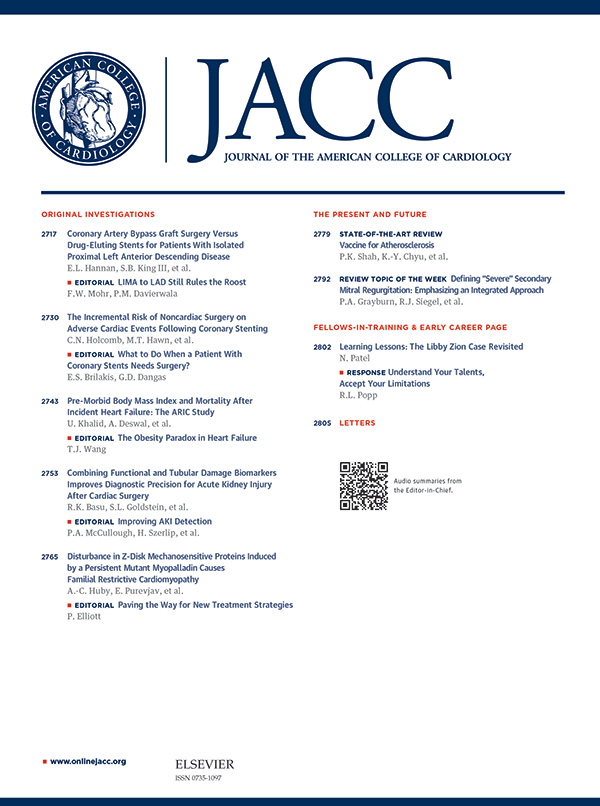长效因子XI抑制与围术期出血:azalea - timi71的分析
IF 21.7
1区 医学
Q1 CARDIAC & CARDIOVASCULAR SYSTEMS
引用次数: 0
摘要
在AZALEA-TIMI 71(一项多中心、随机、主动对照研究,以评估两种盲法剂量阿贝拉西单抗与开放标签利伐沙班在房颤患者中的安全性和耐受性-心肌梗死溶栓71)中,与利伐沙班相比,阿贝拉西单抗作为一种新型因子XI抑制剂,可显著降低房颤(AF)患者的主要或临床相关的非主要(CRNM)出血率。阿贝拉西单抗是长效的,半衰期为~ 28天。目的:本研究的目的是在阿贝拉西单抗抑制长效因子XI的情况下,检查有创手术患者的术中出血情况。方法设计azalea - timi 71,比较阿贝拉西单抗与利伐沙班的出血情况。患者被随机分配到2次阿贝拉西单抗剂量中的1次(每月皮下注射90或150毫克)或每日利伐沙班。随访期间发生的侵入性手术分为低、中、高风险出血。围手术期出血事件被确定为大出血/CRNM出血,由临床事件委员会对治疗分配进行盲法判断,发生在手术后30天内,并与盲法评价的手术有关。结果441例患者共进行了920次手术,在中位随访2.1年期间,利伐沙班和阿韦拉西单抗组中约有1 / 3的患者接受了有创手术。大多数手术是低出血风险(n = 696, 75.7%)和选择性(n = 686, 74.6%)。从最后一次给药到一次手术的中位时间为29天(Q1-Q3: 20-42天),602例中有336例(55.8%)发生在阿贝拉西单抗组的每月给药间隔内。总的来说,围手术期大出血或CRNM出血的发生率很低(占所有手术的2%),阿贝拉西单抗组占所有手术的1.2%,而利伐沙班组占2.2% (RR[风险比]:0.54;95% CI: 0.19-1.58),在单个阿贝拉西单抗给药组中结果一致。对于阿贝拉西单抗剂量后30天内发生的手术,336例手术中只有3例(0.9%)发生大出血或CRNM出血。结论:这些数据表明,接受长效因子XI抑制剂阿贝拉西单抗治疗的房颤患者可以接受低出血率的侵入性手术。此外,这些发现表明,在因子XI抑制的情况下,常规中断抗凝治疗可能不是所有手术都需要的,特别是对于出血风险低的手术。本文章由计算机程序翻译,如有差异,请以英文原文为准。

Long-Acting Factor XI Inhibition and Periprocedural Bleeding
Background
In AZALEA-TIMI 71 (A Multicenter, Randomized, Active-Controlled Study to Evaluate the Safety and Tolerability of Two Blinded Doses of Abelacimab Compared with Open-Label Rivaroxaban in Patients with Atrial Fibrillation–Thrombolysis In Myocardial Infarction 71), abelacimab, a novel factor XI inhibitor, significantly reduced the rate of major or clinically relevant nonmajor (CRNM) bleeding compared with rivaroxaban in patients with atrial fibrillation (AF). Abelacimab is long-acting with a half-life of ∼28 days.
Objectives
The purpose of this study was to examine periprocedural bleeding among patients undergoing invasive procedures in the context of long-acting factor XI inhibition with abelacimab.
Methods
AZALEA-TIMI 71 was designed to assess the bleeding profile of abelacimab relative to rivaroxaban. Patients were randomized to either 1 of 2 abelacimab doses (90 or 150 mg subcutaneously monthly) or to rivaroxaban daily. Invasive procedures occurring during follow-up were categorized as low, intermediate, or high bleeding risk. Periprocedural bleeding events were identified as major/CRNM bleeds, as adjudicated by a clinical events committee blinded to treatment assignment, occurring within 30 days after a procedure, and related to the procedure on blinded review.
Results
A total of 920 procedures occurred in 441 patients, with approximately 1 in 3 patients in both rivaroxaban and abelacimab arms undergoing an invasive procedure over a median follow-up of 2.1 years. Most procedures were low bleeding risk (n = 696, 75.7%) and elective (n = 686, 74.6%). The median time to a procedure from the last dose of abelacimab was 29 days (Q1-Q3: 20-42 days), with 336 of the 602 (55.8%) procedures in the abelacimab arms occurring within the monthly dosing interval. Overall, the occurrence of periprocedural major or CRNM bleeding was low (<2% of all procedures), representing 1.2% of all procedures in the abelacimab arms vs 2.2% of all procedures in the rivaroxaban arm (RR [risk ratio]: 0.54; 95% CI: 0.19-1.58), with consistent results in the individual abelacimab dosing arms. For procedures occurring within 30 days of an abelacimab dose, major or CRNM bleeds occurred in only 3 of the 336 (0.9%) procedures.
Conclusions
These data illustrate that patients with AF treated with abelacimab, a long-acting factor XI inhibitor, can undergo invasive procedures with low rates of bleeding. Moreover, these findings suggest that routine interruption of anticoagulation may not be necessary for all procedures in the context of factor XI inhibition, particularly for procedures that have low bleeding risk.
求助全文
通过发布文献求助,成功后即可免费获取论文全文。
去求助
来源期刊
CiteScore
42.70
自引率
3.30%
发文量
5097
审稿时长
2-4 weeks
期刊介绍:
The Journal of the American College of Cardiology (JACC) publishes peer-reviewed articles highlighting all aspects of cardiovascular disease, including original clinical studies, experimental investigations with clear clinical relevance, state-of-the-art papers and viewpoints.
Content Profile:
-Original Investigations
-JACC State-of-the-Art Reviews
-JACC Review Topics of the Week
-Guidelines & Clinical Documents
-JACC Guideline Comparisons
-JACC Scientific Expert Panels
-Cardiovascular Medicine & Society
-Editorial Comments (accompanying every Original Investigation)
-Research Letters
-Fellows-in-Training/Early Career Professional Pages
-Editor’s Pages from the Editor-in-Chief or other invited thought leaders

 求助内容:
求助内容: 应助结果提醒方式:
应助结果提醒方式:


